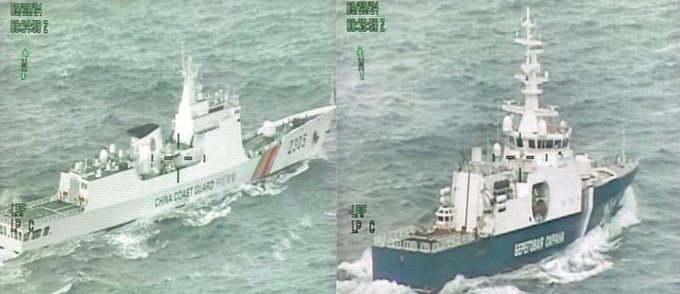In a chilling display of geopolitical maneuvering, China and Russia have launched their first-ever joint Arctic patrol, sending shockwaves through the international community as their flotilla ventures perilously close to the icy frontiers of Alaska. Just a week after the U.S. Coast Guard (USCG) reported sightings of these formidable vessels 500 miles southwest of Alaska, the Chinese-Russian convoy has audaciously breached the 12 nautical mile threshold, sailing just outside U.S. territorial waters near the Seward Peninsula.
The convoy, comprising two Chinese Coast Guard frigates—Meishan and Xiushan—and two stealthy Russian border patrol ships, sliced through the frigid waters of the Bering Strait and the treacherous Chukchi Sea in a calculated maneuver that sends a stark warning to the United States. Departing Vladivostok in mid-September, the flotilla embarked on a mission that signals a bold assertion of Sino-Russian dominance in the Arctic, a region now more coveted than ever due to its vast untapped resources and emerging navigable routes courtesy of relentless climate change.
AIS vessel tracking data and corroborating satellite imagery have confirmed the convoy’s strategic path, gliding in single file between Little Diomede Island and the Alaskan mainland. This brazen move not only marks the northernmost approach of Chinese Coast Guard vessels into the Alaskan sphere but also underscores the intensifying rivalry between global superpowers vying for supremacy in the Arctic’s frozen expanse.
Rear Adm. Megan Dean, commander of the 17th Coast Guard District, issued a stern warning about the “increasing interest strategic competitors have in the Arctic region.” “The demand for Coast Guard services across the region continues to grow, requiring continuous investment in our capabilities to meet our strategic competitors’ presence and fulfill our statutory missions across an expanding operational area,” she stated, highlighting the urgent need for the U.S. to bolster its Arctic defenses.
Despite these clear threats, the USCG finds itself hamstrung by a critical shortage of icebreakers and Arctic-capable long-range patrol vessels, leaving the nation vulnerable as Chinese and Russian forces stake their claims in these icy waters. While past efforts, such as the 2013 Coast Guard Arctic Strategy, foresaw China’s burgeoning polar ambitions, the reality today is far more alarming. China’s relentless expansion, marked by the deployment of advanced icebreakers and research vessels, poses a formidable challenge to the United States’ Arctic hegemony.
The joint patrol’s audacity extends beyond mere presence; it is a calculated assertion of territorial claims and a strategic positioning that could reshape the balance of power in the Arctic. As the convoy maneuvers closer to Alaska, the implications are profound. Resource-rich territories, new maritime routes, and the sheer symbolic power of control in the Arctic make this patrol a high-stakes game of chess on a frozen board.
The U.S. Coast Guard’s response remains tepid, primarily due to the unavailability of key assets like the Healy and Polar Star icebreakers, both currently sidelined for emergency repairs and maintenance. This glaring gap in the USCG’s arsenal not only hampers immediate response capabilities but also signals a dire need for accelerated investment and strategic planning to counteract the growing Chinese-Russian foothold.
As satellite images capture the icy silhouettes of the Chinese-Russian patrol fleet, the world watches with bated breath. The message is clear: the Arctic is no longer the exclusive playground of traditional Arctic nations. China and Russia are rewriting the rules, staking their claims with unwavering determination, and the United States must rise to the occasion or risk losing its sovereignty and strategic interests in one of the world’s most critical and contested regions.
With the Arctic ice melting faster each year, opening new shipping lanes and revealing hidden reserves of oil and gas, the strategic importance of this region cannot be overstated. The joint patrol is not just a show of force; it’s a strategic maneuver to secure resources and establish control before the rest of the world can even react.
As tensions mount and the Arctic becomes a new frontier for global power struggles, the eyes of the world are on Alaska. Will the United States manage to fortify its Arctic presence and counteract the bold moves of China and Russia? Or will the frozen battleground shift irreversibly in favor of the rising Eastern powers? The answer lies in the coming months, as the Arctic race heats up under the unforgiving gaze of the polar sun.
Stay tuned as this Arctic drama unfolds, reshaping the geopolitical landscape and testing the mettle of nations vying for dominance in the world’s newest frontier.












